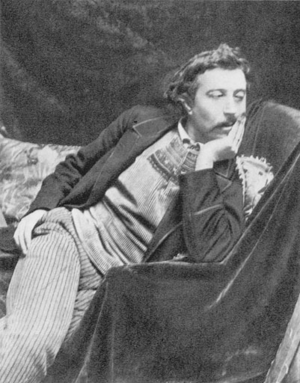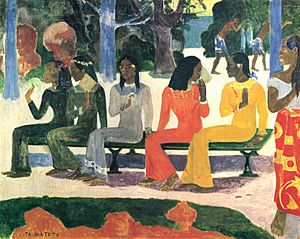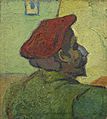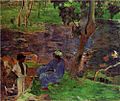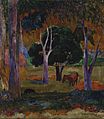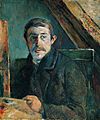Paul Gauguin facts for kids
Quick facts for kids
Paul Gauguin
|
|
|---|---|
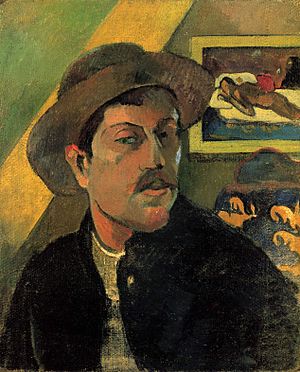
Self-portrait, 1893, Musée d'Orsay
|
|
| Born |
Eugène Henri Paul Gauguin
7 June 1848 |
| Died | 8 May 1903 (aged 54) Atuona, Marquesas Islands, French Polynesia
|
| Nationality | French |
| Known for | Painting, sculpture, ceramics, engraving |
| Movement | Impressionism, Post-Impressionism, Primitivism |
| Spouse(s) |
Mette-Sophie Gad
(m. 1873; div. 1894) |
Eugène Henri Paul Gauguin (born June 7, 1848 – died May 8, 1903) was a very important French painter. He is known for his unique style. Gauguin was not famous for his art until after he died.
He became known for using bright colors and a special style. This was different from the Impressionism art movement. His work inspired many French artists. Later, famous painters like Pablo Picasso and Henri Matisse were also influenced by him. Gauguin's art became popular thanks to an art dealer named Ambroise Vollard.
In 1891, Gauguin left his family and life in Europe. He moved to Tahiti to live and paint. He passed away there in 1903.
Contents
Paul Gauguin's Early Life and Family
Paul Gauguin was born in Paris, France. His father, Clovis Gauguin, was a journalist. His mother, Aline Maria Chazal, was half-Peruvian. Her mother was Flora Tristan, a leader who believed in socialism.
In 1851, Paul's family left Paris. They moved to Peru because of the political situation in France. Sadly, Clovis died during the trip. This left three-year-old Paul, his mother, and his sister alone. They lived for four years in Lima, Peru with Paul's uncle. The images and culture of Peru later influenced Paul's art.
When Paul was seven, his family returned to France. They moved to Orleans, France, to live with his grandfather. Paul quickly learned French and did very well in school.
At age seventeen, Gauguin joined the merchant marine as a pilot's assistant. This was part of his required military service. Three years later, he joined the navy for two years. In 1871, Gauguin returned to Paris. He found a job as a stockbroker. In 1873, he married Mette Sophie Gad, a woman from Denmark. They had five children over the next ten years.
Gauguin's Journey into Art
Gauguin had been interested in art since he was a child. In his free time, he started painting. He also visited art galleries often. He bought paintings from new artists. Gauguin became friends with the artist Camille Pissarro. Pissarro introduced him to many other artists.
As Gauguin improved his art, he rented a studio. He showed his paintings in Impressionist art shows in 1881 and 1882. For two summers, he painted with Pissarro. Sometimes, he also painted with Paul Cézanne.
By 1884, Gauguin and his family moved to Copenhagen. He tried to have a business career there, but it did not work out. He then decided to paint full-time. In 1885, he returned to Paris, leaving his family in Denmark. He did not earn enough money from his art. So, his wife and their five children went back to live with her family. Gauguin lived longer than two of his children.
New Artistic Styles and Influences
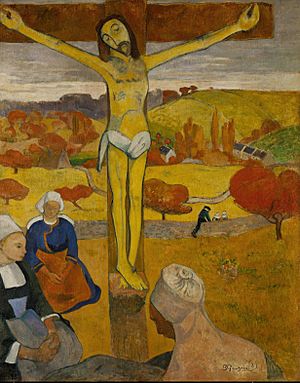
Gauguin was not happy with Impressionism. He felt that traditional European painting was too much like copying. He thought it lacked deeper meaning. In contrast, he felt that art from Africa and Asia was full of special symbols. Art from other cultures, especially Japanese prints, became very popular in Europe at that time.
Gauguin was invited to show his work at an exhibition in 1889. This show was organized by a group called Les XX. Influenced by folk art and Japanese prints, Gauguin developed a style called Cloisonnism. In this style, images are often made of flat areas of pure color. These colors are separated by thick black lines. In these works, Gauguin did not use traditional perspective. He also did not use many shades of color. The Yellow Christ (1889) is a very famous painting in the Cloisonnist style.
Life in Tahiti and the Marquesas Islands
In 1891, Gauguin was frustrated because his art was not recognized in Europe. He also did not have a steady income. He sailed to the tropics to get away from European life. He wanted to escape "everything that is artificial and conventional." Before this, he had tried to find a tropical paradise. He wanted to live simply and paint in his new, more primitive style. He had short stays in Martinique and worked on the Panama Canal.
Gauguin lived in Mataiea Village in Tahiti. There, he painted "Fatata te Miti" ("By the Sea") and "Ia Orana Maria" (Ave Maria). He also painted many other scenes of Tahitian life. In 1897, he moved to Punaauia. There, he created his famous painting "Where Do We Come From." He then spent the rest of his life in the Marquesas Islands. He only returned to France once.
His paintings from this time are full of religious symbols. They also show his views of the people of Polynesia. In Polynesia, he supported the native people. He often had disagreements with the colonial authorities. During this period, he also wrote a book called Avant et Après ("Before and After"). This book was a collection of his thoughts about life in Polynesia. It also included memories from his life and comments on literature and paintings.
In 1903, Gauguin had a disagreement with the government. He was sentenced to three months in prison and had to pay a fine. He was being supported by an art dealer at that time. He died in 1903, at the age of 54, before he could start his prison sentence.
Gauguin was buried in Calvary Cemetery, Atuona (Cimetière Calvaire). This cemetery is in Atuona, Hiva ‘Oa, Marquesas Islands, French Polynesia.
Gauguin's Famous Sayings
Here are some things Paul Gauguin said:
- "To do something new, we must go back to the beginning, to humanity when it was young."
- "How do you see this tree? Is it really green? Use green, then, the most beautiful green on your palette. And that shadow, rather blue? Don't be afraid to paint it as blue as possible."
- "Art is either copying or a revolution."
- "I close my eyes to see."
- "Where do we come from? What are we? Where are we going?"
Gauguin's Lasting Impact
Gauguin became truly famous after he died. A Russian collector named Sergei Shchukin bought many of his later paintings. A large part of his collection is now in the Pushkin Museum and the Hermitage. Gauguin's paintings are rarely sold. When they are, their price can be very high, sometimes over $39.2 million US Dollars.
Gauguin influenced many other painters. One important connection is with Arthur Frank Mathews. Mathews used very bright colors in his art. He met Gauguin in the late 1890s. Mathews used this influence to start the California Arts and crafts or California Decorative movement.
The Japanese-style Gauguin Museum is in Papeari, Tahiti. It is across from the Botanical Gardens of Papeari. The museum has exhibits, documents, photos, and copies of Gauguin's sketches and prints. In 2003, the Paul Gauguin Cultural Center opened in Atuona in the Marquesas Islands.
Paul Gauguin's life inspired the book The Moon and Sixpence by Somerset Maugham. His life is also the subject of an opera called Gauguin (a synthetic life) by Michael Smetanin and Alison Croggon. His art continues to inspire many artists today, such as Amanda Faulkner, Alex Katz, and Will Teather.
Images for kids
-
Gauguin with his wife Mette in Copenhagen, Denmark, 1885
-
Four Breton Women, 1886, Neue Pinakothek, Munich
-
Poster of the 1889 Exhibition of Paintings by the Impressionist and Synthetist Group, at Café des Arts, known as The Volpini Exhibition, 1889
-
Martinique Landscape 1887, Scottish National Gallery
-
Vincent van Gogh, Paul Gauguin (Man in a Red Beret), 1888, Van Gogh Museum, Amsterdam
-
Paul Gauguin, Arearea no Varua Ino,1894, watercolor monotype on Japan paper, owned originally by Degas, National Gallery of Art
-
Père Paillard (Father Lechery), 1902, National Gallery of Art. Gauguin's lampoon of Bishop Martin.
-
Women Bathing, 1885, National Museum of Western Art, Tokyo
-
La Bergère Bretonne, 1886, Laing Art Gallery
-
Breton Girl, 1886, Burrell Collection, Glasgow
-
Still Life with Profile of Laval (Charles Laval), 1886, Indianapolis Museum of Art
-
Tehura (Teha'amana), 1891–3, polychromed pua wood, Musée d'Orsay, Paris
-
Oyez Hui Iesu (Christ on the Cross), rubbing (reverse print) from an 1896 wooden cylinder, Museum of Fine Arts, Boston
-
Self-portrait, 1875–1877, Fogg Museum, Cambridge, Massachusetts
-
Self-portrait, 1885, Kimbell Art Museum, Fort Worth, Texas
-
Self-Portrait with Halo and Snake, 1889, National Gallery of Art, Washington, DC
-
Christ in the Garden of Olives (Gauguin's self-portrait) 1889, Norton Museum of Art
-
Jug in the Form of a Head, Self-Portrait, 1889. Kunstindustrimuseet, Copenhagen
-
Self-portrait, 1889–1890, Musée d'Orsay, Paris
-
Self-portrait, 1893, Musée d'Orsay
-
Self-portrait, c. 1893, Detroit Institute of Arts
-
Self-portrait, 1896, São Paulo Museum of Art
-
Self-portrait (for my friend Daniel), 1896, Musée d'Orsay
| Article contributor: Beau Tardy. Beau is a French-American artist specializing in electronic imagery, computer art, video and television. His artworks were shown internationally at the Barcelona Biennale, the Contemporary Art Center in New Orleans, Sydney, Paris and New York. |
See also
 In Spanish: Paul Gauguin para niños
In Spanish: Paul Gauguin para niños


